
The Gunboat War was a naval conflict between Denmark–Norway and Great Britain supported by Sweden during the Napoleonic Wars. The war's name is derived from the Danish tactic of employing small gunboats against the materially superior Royal Navy. In Scandinavia it is seen as the later stage of the English Wars, whose commencement is accounted as the First Battle of Copenhagen in 1801.

Jens Schou Fabricius was the Norwegian appointed Minister of the Navy 1817–1818. He served as a representative for Søe-Deffensionen at the Norwegian Constitutional Assembly at Eidsvoll in 1814. During his naval career he served first the Danish Crown until the separation in 1814 of Norway from Denmark, and thereafter the Norwegian-Swedish Crown. Fabricius retired from the navy as a vice admiral.

John Perkins, nicknamed Jack Punch, was a British Royal Navy officer. Perkins was perhaps the first mixed race commissioned officer in the Royal Navy. He rose from obscurity to be a successful ship's captain in the Georgian Royal Navy. He captained a 10-gun schooner during the American War of Independence and in a two-year period captured at least 315 enemy ships.

HMS Arab was a 22-gun post ship of the Royal Navy. She was formerly the 18-gun French privateer Brave, which the British captured in 1798. She served during the French Revolutionary and Napoleonic Wars until she was sold in 1810.
Three ships of the Royal Danish Navy have borne the name HDMS Lougen. The name "Lougen" is derived from the river Laagen in Norway.
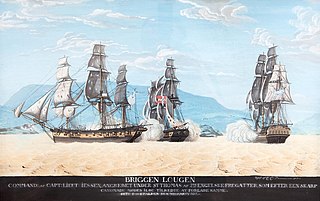
HDMS Lougen was a brig of 18 guns, launched in 1791, and the name-vessel of her class of six brigs designed by the naval architect Ernst Stibolt. She was the first Danish warship to be copper-sheathed. She was active protecting Danish merchant shipping and suppressing pirates in the Mediterranean and in the Caribbean. In March 1801, she fought off the British privateer Experiment and the 22-gun warship HMS Arab in a single action. When the British captured the Danish West Indies in 1801, Lougen was part of the booty. The British later returned her to Denmark where she was broken up in 1802.
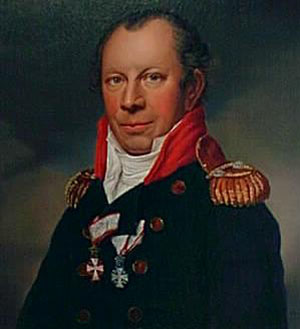
Carl Wilhelm Jessen was a Danish naval officer and Governor of St Thomas in the Danish West Indies.
Events from the year 1801 in Denmark.
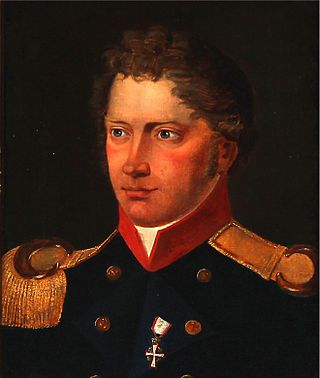
Peter Nicolay Skibsted (1787–1832) was a Danish naval officer with a successful career marred only by the loss in 1810 of a squadron of three gunboats under his command to the British.
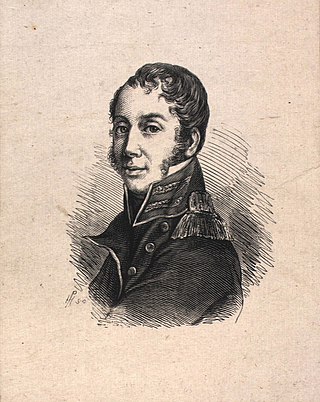
Hans Peter Holm was a Danish naval officer who commanded vessels of the Dano-Norwegian Navy in several actions. He commanded several naval vessels during the Gunboat War. His most important action occurred in 1812 at the Battle of Lyngør when a British squadron, led by the British ship-of-the-line HMS Dictator, destroyed his vessel, HDMS Najaden. Holm sustained wounds in the battle but survived, only to drown in an accident shortly afterwards.
The name of Steen Andersen Bille is closely associated with one extended family of Danish naval officers over several generations.
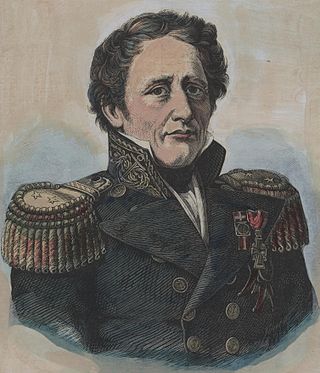
Jochum Nicolay Müller was a Norwegian naval officer who, as a midshipman, excelled at mathematics. As a junior lieutenant he met Horatio Nelson, and as a captain commanded the Finnmark squadron. He finally rose to the rank of Vice Admiral in the independent Royal Norwegian Navy.

HDMS Friderichssteen or HMS Frederichsteen was a Danish Navy frigate, built in 1800, and captured by the Royal Navy in 1807 at the Battle of Copenhagen. She was taken into service as HMS Fredericksteen and served in the Mediterranean until being finally broken up in 1813.
Frederik Christian Hals von Moth was a Danish merchant, nobleman, colonial administrator and planter who served as Governor-General of St. Thomas and St. John in the Danish West Indies from April 1724 - May 1727 then again from 21 February 1736 - 13 April 1744. In addition, he served as Governor of St. Croix from 8 January 1735 - 15 May 1747. In 1736, his title was changed to Governor General (generalguvernør). His military rank was Commander (kommandørkaptajn). In addition, he held the rank of justitsråd.

Henrik Gerner (1742–1787) was a Danish naval officer who specialised in shipbuilding and naval architecture. His interests as an entrepreneurial engineer led to unsinkable gun platforms, horse-driven dredging machines, and desalination equipment for Orient-bound trading ships.

Ernst Wilhelm Stibolt was a Danish naval officer and ship builder, who served in the French navy for four years. and became a member of the Royal Danish Academy of Sciences and Letters.

Frantz Christopher Henrik Hohlenberg was a Danish naval officer who specialised in ship design and had little seagoing experience. He succeeded Ernst Wilhelm Stibolt as Master Shipbuilder (fabriksmester) at the Royal Danish Dockyards in 1796. His ships included five ships of the line and 18 frigates. Three of the ships of the line and nine of the frigates were captured at the 1807 Battle of Copenhagen and subsequently added to the Royal Navy. He resigned after a controversy in 1803.
HDMS Nidelven was a brig launched at Copenhagen on 1 December 1792. She was present at both British attacks on Copenhagen, and the British Royal Navy seized her at Copenhagen on 7 September 1807 at the surrender of Copenhagen. The British took her into service as HMS Nid Elven. She served between 1808 and 1809, during which time she captured a small French privateer. She was laid up in 1809. The Navy sold her in 1814.
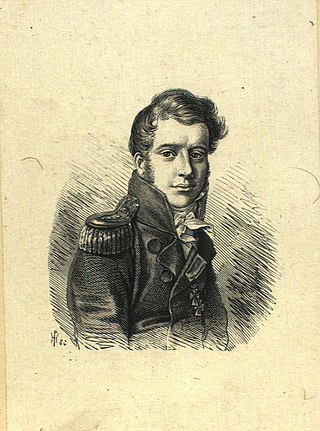
Broder Knud Brodersen Wigelsen was an officer in the Royal Danish-Norwegian navy at the time of the gunboat war with Britain. After the war he served in various capacities, principally in the Danish customs service.

Edouard Suenson was a Danish vice admiral known for his participation in the First and Second Schleswig War, and served as the main Danish commander at the Battle of Heligoland in the latter.


















